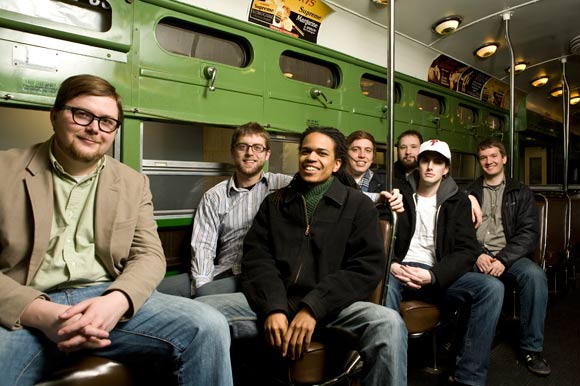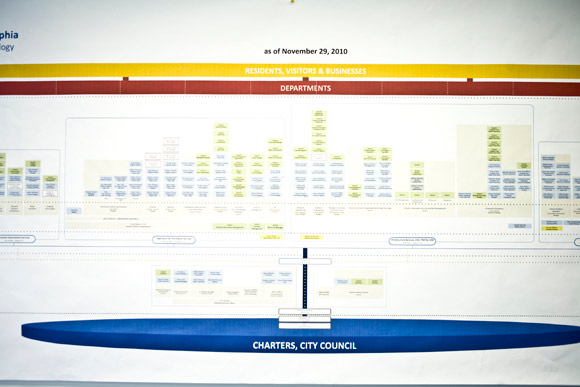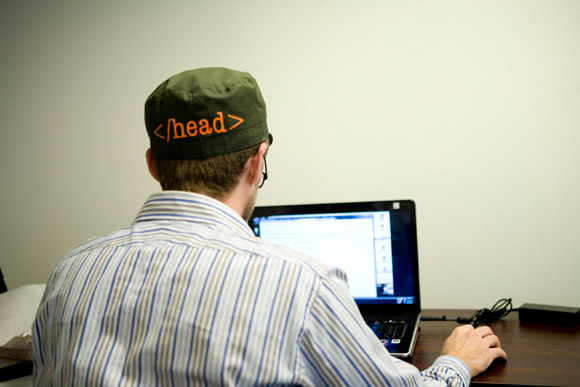 Brett’s grabbing a beer with a friend at Fergie’s in Philadelphia on a cold, wintry January day. He knows he has to take the 38 bus back home to the Art Museum area and doesn’t want to wait outside longer than necessary. But luckily the app on his cell phone tells him that the bus is running late; he can wait a few more minutes before heading out in the cold.
Brett’s grabbing a beer with a friend at Fergie’s in Philadelphia on a cold, wintry January day. He knows he has to take the 38 bus back home to the Art Museum area and doesn’t want to wait outside longer than necessary. But luckily the app on his cell phone tells him that the bus is running late; he can wait a few more minutes before heading out in the cold.
Rachel is looking for a permanent spot in the city’s Fishtown neighborhood, and sees a townhouse she loves: large windows, a roof deck, and a gorgeous kitchen. When she gets home, she puts the address into the new website she heard about and immediately the historical records, tax information, inspection records, blueprints, mortgages, and variances for the property are available. She learns that the previous owner didn’t pay their taxes, and the house had a mold infestation early last year. Crisis averted. Do you wish the above scenarios were fact instead of fiction? If so, you’re not alone. Philadelphia’s Department of Technology has made creating a transparent city government a priority, and they have recruited the Code for America program to help make it a reality. Though the program just kicked off in January, the Code for America fellows have already served as a bridge in drawing the civic and tech communities in Philadelphia closer together, and started to make an impact in the space around civic applications.
Do you wish the above scenarios were fact instead of fiction? If so, you’re not alone. Philadelphia’s Department of Technology has made creating a transparent city government a priority, and they have recruited the Code for America program to help make it a reality. Though the program just kicked off in January, the Code for America fellows have already served as a bridge in drawing the civic and tech communities in Philadelphia closer together, and started to make an impact in the space around civic applications.
The focus of the DOT’s efforts towards transparency lies in making currently private data sets public, in an initiative called OpenDataPhilly. Some of the data the city currently houses on its servers includes information around who is calling the government’s 311 hotline and why, crime statistics by neighborhood and type, and geo-spatial data – including real estate and park information. Much of this data will be released in April, during the inaugural Philly Tech Week. With open data, citizens will have access to this information in real time, and developers can create applications to visualize and apply this data in new and unique ways. That’s where the Code for America program fits in. Code for America is a year-long non-profit program dedicated to improving the way city governments function. In this, their inaugural year, 12 cities submitted applications but only four were chosen. Philadelphia joined Washington DC, Seattle, and Boston in attaining the services of a set of developers and designers who will be dedicated to making city government more transparent.
That’s where the Code for America program fits in. Code for America is a year-long non-profit program dedicated to improving the way city governments function. In this, their inaugural year, 12 cities submitted applications but only four were chosen. Philadelphia joined Washington DC, Seattle, and Boston in attaining the services of a set of developers and designers who will be dedicated to making city government more transparent.
In Philadelphia, the Code for America fellows have been tasked to develop a civic application that both connects citizens to government services and to other citizens within the framework of a neighborhood. In the words of Department of Technology Chief of Staff Jeff Friedman, “You don’t say you live in a council district, police district, and a sanitation district, you say you live in East Falls, or Fishtown, or South Philly”. While the city of Philadelphia assigns district numbers to locations, people use neighborhood names. The civic application being developed by the Code for America developers will allow citizens to communicate within that familiar context. With the Code for America project, the city was able to get a group of talented, driven developers. Most of the fellows are taking a financial hit to work on a public service project that they believe in. Says Aaron Ogle, the unofficial leader of the group: “We love Philly. This is our community, this is our home. We want to start taking some of these problems into our own hands and making this city as great as it can be”. While only two of the seven Code for America fellows are from Philadelphia, the application they are working on will be open source, making it possible to re-purpose it for another city if desired.
With the Code for America project, the city was able to get a group of talented, driven developers. Most of the fellows are taking a financial hit to work on a public service project that they believe in. Says Aaron Ogle, the unofficial leader of the group: “We love Philly. This is our community, this is our home. We want to start taking some of these problems into our own hands and making this city as great as it can be”. While only two of the seven Code for America fellows are from Philadelphia, the application they are working on will be open source, making it possible to re-purpose it for another city if desired.
The Philadelphia crew has formed close bonds in their short time together. Pete Fecteau, a graphic designer and probably the most creative of the group, gave a talk at Ignite Philly in which he described his appreciation for being selected to the Code for America team, and the importance of being “the dumbest person in the room”. The group is not afraid to poke fun at themselves, but place a high value on the ideals of a transparent city government. Most of the work on the Code for America application will take place in San Francisco during the months of March through November, with the core technology being complete by the end of August. During the month of February, however, the fellows were in Philadelphia conducting over 100 interviews to help inform their project. The interviews included government employees, community leaders, and ordinary citizens – ranging from hour-long sit-downs with Mayor Michael Nutter and Deputy Mayor of Public Safety Everett Gillison to police car ride-alongs, seeing first-hand what data cops entered into their tracking system. While the interviews were private, the fellows plan to release an anonymized summary report of their findings before the summer.
Most of the work on the Code for America application will take place in San Francisco during the months of March through November, with the core technology being complete by the end of August. During the month of February, however, the fellows were in Philadelphia conducting over 100 interviews to help inform their project. The interviews included government employees, community leaders, and ordinary citizens – ranging from hour-long sit-downs with Mayor Michael Nutter and Deputy Mayor of Public Safety Everett Gillison to police car ride-alongs, seeing first-hand what data cops entered into their tracking system. While the interviews were private, the fellows plan to release an anonymized summary report of their findings before the summer.
The fellows made it a priority to engage the technical and civic communities in their project, to ensure the energy around civic applications continues after they leave for San Francisco. Their final week in Philadelphia included a panel discussion, a brainstorming event, and an all day hackathon. The hackathon, dubbed DataCamp, gave Philadelphia-area developers a chance to collaborate with the Code for America developers on projects that could help improve the lives of citizens. Mark Headd, a developer evangelist who works principally in the realm of civic applications, dubbed the influx of energy created by the developers “the CfA Effect.“
The energy brought by the Code for America fellows and fostered by the city of Philadelphia’s push towards open data should continue even in their absence. When the CfA application is handed off to the city in November, it will be one of many newly created civic applications – helping to make Philadelphia an easier place to buy a house, ride a bus, and engage with city services.
Salas Saraiya reports on the technology community. Though he’s had a license for more than a decade, his next car will be his first. He loves Philly for its micro-brews, roof decks, and independent spirit. Send feedback here.
PHOTOS:
The Code for America crew, from left: Pete Fecteau, John Mertens, Mjumbe Poe, Tyler Stalder, Matt Lewis, Michael Evans and Aaron Ogle
Typical day at the office
A map of city departments used by the team as reference
John Mertens working things out in his head
Matt Lewis
All photographs by MICHAEL PERSICO
